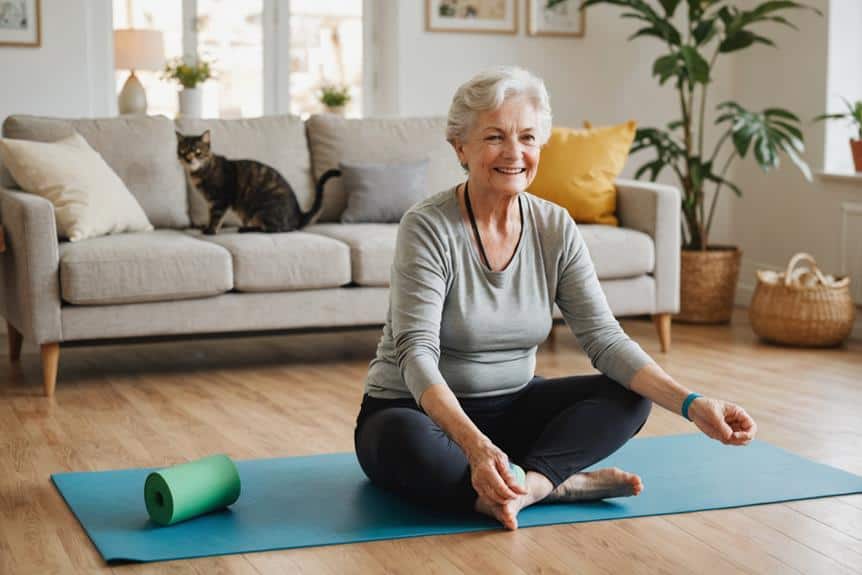Seniors with limited mobility can still enjoy effective exercises to enhance their health. Consider chair-based workouts, like arm circles and leg lifts, which are safe and promote circulation. Gentle stretching techniques, such as seated yoga or toe-tapping, improve flexibility without straining joints. Additionally, practicing balance exercises, like ankle stretches, can enhance stability and confidence. It's important to listen to your body and start slowly, gradually increasing intensity. Remember to set achievable goals and create a supportive environment. Engaging in these activities not only boosts physical health but also uplifts your mood. There's so much more you can explore!
Importance of Regular Exercise
Additionally, the health benefits of regular exercise extend beyond just physical fitness. Engaging in physical activity can alleviate symptoms of depression and anxiety, promoting better mental wellness. This is particularly important for seniors who may face feelings of isolation, as highlighted in the emotional challenges of caregiving. When you exercise, you release endorphins, which can foster a more positive outlook on life. This boost in mood is crucial as it helps you feel more connected and engaged with the world around you.
Regular physical activity also plays an essential role in promoting independence. By improving your balance and coordination, you can reduce the risk of falls and related injuries, which can be a significant concern for seniors. Additionally, incorporating exercise into your daily routine enhances your overall quality of life. You'll likely experience increased energy levels, allowing you to participate more in social and community activities.
In short, don't underestimate the importance of regular exercise. It's a powerful tool for enhancing both your physical and mental well-being, helping you lead a more active and fulfilling life.
Safe Exercises for Limited Mobility
When you're looking for safe exercises with limited mobility, chair-based activities can be a great starting point. Gentle stretching techniques and balance practices not only help improve your strength and flexibility but also boost your overall stability. Remember, it's important to ease into these exercises to guarantee safety and enhance your independence.
Chair-Based Exercises
Engaging in chair-based exercises can be a fantastic way for seniors with limited mobility to stay active and improve their overall health. These exercises provide a safe and effective means to enhance strength, flexibility, and well-being while minimizing the risk of injury. Movements like leg lifts, arm circles, and seated twists can be easily performed from your chair, targeting various muscle groups.
You can also make chair modifications to suit your comfort level, allowing you to gradually increase intensity and repetitions as you gain strength. Including exercise accessories, like resistance bands or small weights, can further enhance your workouts, making them more effective and engaging.
Regularly performing chair exercises not only improves circulation and reduces stiffness but also supports mental health by boosting your mood. By incorporating these exercises into your daily routine, you promote independence and confidence, empowering yourself to stay active and engaged in life. Remember, it's important to listen to your body and adjust movements as needed, ensuring a positive and fulfilling exercise experience. Take small steps today, and you'll likely notice significant benefits over time!
Gentle Stretching Techniques
You can also enhance your stretching routine by including dynamic stretches and seated yoga. Using simple props, like exercise bands or light weights, can boost effectiveness without straining your joints. This promotes strength alongside flexibility.
Here's a quick reference table to contemplate:
| Stretch Type | Description |
|---|---|
| Toe-Tapping | While seated, lift your toes towards your shins, then lower them. Repeat for 10-15 reps. |
| Gentle Side Bends | While seated, bend to one side, reaching your arm overhead. Hold for a few seconds and switch sides. |
| Seated Forward Bend | Sit tall, inhale, and reach forward gently, feeling a stretch in your back. Hold for a few breaths. |
Incorporating these practices into your routine can considerably improve your overall well-being.
Balance and Stability Practices
Incorporating gentle stretches and chair exercises into your daily routine can improve proprioception and coordination, which are key for staying steady on your feet. Ankle stretches and hip marching while seated not only maintain flexibility in your lower body but also support safe movement.
When you perform these stability drills, consider using a sturdy chair or wall for support. This provides the confidence needed to practice balance activities safely. Engaging in regular balance training, even for short periods, leads to measurable improvements in your steadiness and confidence while walking or standing.
Chair-Based Workouts
Chair workouts can be adapted to fit your individual abilities, allowing you to participate regardless of your fitness level. This adaptability means you can make use of adaptive modifications, ensuring that you feel comfortable and secure while exercising. Regular participation in these workouts helps maintain muscle tone and strength, reducing the risk of falls, and enhancing your balance and coordination.
To give you a clearer idea of chair-based workouts, here's a simple table outlining some exercises:
| Exercise | Repetitions | Benefits |
|---|---|---|
| Arm Circles | 10-15 | Improves shoulder mobility |
| Leg Lifts | 10-15 | Strengthens leg muscles |
| Seated Marches | 1-2 minutes | Boosts cardiovascular health |
| Seated Torso Twist | 5-10 | Enhances spinal flexibility |
Incorporating chair-based workouts into your routine can promote better circulation, mobility, and mental well-being, fostering a sense of independence and an improved quality of life.
Benefits of Gentle Stretching
Gentle stretching can greatly enhance your flexibility and mobility, making daily activities easier and safer. By incorporating these stretches into your routine, you'll reduce muscle tension and improve circulation, which helps with balance and decreases your risk of falls. Not only does stretching benefit your body, but it also promotes relaxation, contributing to your overall well-being.
Enhances Flexibility and Mobility
Chair stretches are a great option, as they can enhance blood circulation, which is essential for your overall health. Improved circulation aids in faster recovery from physical exertion, making it easier to stay active. Additionally, consistent practice of gentle stretching can alleviate discomfort associated with conditions like arthritis, improving your overall comfort and quality of life.
Moreover, incorporating stretching into your daily routine can positively impact your mental well-being. It promotes relaxation and reduces stress, contributing to a more positive outlook on life. By dedicating just a few minutes each day to stretching, you can enhance your flexibility and mobility, leading to a more fulfilling and active lifestyle. Remember, every small step counts toward a healthier, happier you!
Reduces Muscle Tension
Muscle tension can be a common issue for seniors, but incorporating gentle stretching into your routine effectively alleviates it. Gentle stretching promotes muscle relaxation by enhancing blood circulation, which improves oxygen delivery to your muscles and reduces stiffness. When you stretch, you help decrease tension, providing much-needed tension relief.
Regular stretching can also improve your flexibility and range of motion, allowing for more comfortable movements with less pain. Engaging in gentle stretching exercises activates your parasympathetic nervous system, which relaxes your body and lowers stress levels. This is especially beneficial if you've been feeling tense or anxious.
Moreover, stretching can decrease muscle soreness after light physical activity. By including daily gentle stretches, you can aid in quicker recovery, essential for maintaining an active lifestyle. Improved posture from regular stretching is another advantage, as it reduces strain on your muscles and joints, particularly important for seniors with limited mobility.
Improves Circulation and Balance
Incorporating stretching into your daily routine can also increase flexibility, making it easier to perform daily activities. Additionally, stretching stimulates the release of endorphins, improving your mood and reducing feelings of anxiety. This leads to a better quality of life.
Here's a quick overview of the benefits:
| Benefit | Impact on Health | Key Focus |
|---|---|---|
| Enhanced Blood Flow | Prevents blood clots | Circulation |
| Improved Balance | Reduces fall risk | Stability |
| Increased Flexibility | Eases daily activities | Range of Motion |
| Better Mood | Decreases anxiety | Emotional Well-being |
Tips for Staying Active
Set reminders to stand up and move around every hour. This simple strategy enhances circulation and reduces the risks associated with prolonged sitting. It's also beneficial to include short walking intervals at home, such as moving between rooms. These small movements not only build your confidence in mobility but also contribute to improved cardiovascular health. Moreover, consider evaluating your personal care requirements to guarantee that your activities align with your specific needs, especially if you have certain medical conditions that may require specialized care understanding care needs.
Don't underestimate the power of social engagement as a motivation strategy. Connect with friends or family members for a walk or an exercise session. Having a workout buddy can make staying active more enjoyable and provide the encouragement you need to stick with it. Always remember to consult with a healthcare provider before starting any new exercise routine. They can help ascertain that your chosen activities are safe and suitable for your individual health conditions.
Overcoming Exercise Barriers
Creating a safe and supportive environment is essential. This means removing hazards in your workout area and guaranteeing you have the right equipment and supervision. Setting realistic, achievable goals can also boost your confidence and motivation, making it easier to stick with an exercise routine.
Consider the following strategies to help you overcome barriers:
| Challenge | Motivation Strategies |
|---|---|
| Fear of Injury | Start with low-impact exercises and gradually increase intensity. Ensure proper guidance from a fitness specialist. |
| Lack of Motivation | Join a group class or pair up with a friend for accountability and fun. Celebrate small successes to stay inspired. |
| Physical Limitations | Work with a physical therapist to create a tailored plan that accommodates your needs. Focus on what you can do! |
| Emotional Support | Share your goals with family and friends, and ask for their encouragement. Their support can make a big difference! |
Encouragement from loved ones can enhance your commitment to exercise. When you feel supported, you're more likely to engage in regular activity. Always remember that seeking guidance from professionals can provide tailored plans that promote safe participation. With these motivation strategies and a supportive environment, you can make exercise a fulfilling part of your life!





